
Haraldsborg is a historic property located close to Roskilde Fjord in northeastern Roskilde, Denmark. As of 2017 [update] , it is being converted into a Christmas seal home for socially challenged children.

Haraldsborg is a historic property located close to Roskilde Fjord in northeastern Roskilde, Denmark. As of 2017 [update] , it is being converted into a Christmas seal home for socially challenged children.
According to Saxo Grammaticus, Haraldsborg was built by Harald Kesja. It was most likely a ring fortification with palisades. Saxo mentions a revolving wooden tower, but such structures are not known from archeological excavations. [1] Harald Kesja plundered far and wide, which greatly contributed to his not being elected king after his father died in 1103. Instead, his uncle Niels of Denmark was elected king in 1104. In 1133, Haraldsborg came under siege by Harald's half-brother Eric Emune and fell after local German craftsmen from Roskilde had assisted Eric in the construction of a trebuchet. Haraldsborg was part of Queen Dorothea's dower lands.
Hendrik Behrmann claims that the last remains of Haraldsborg were destroyed by German soldiers during the Count's Feud in 1534. [2]

A watermill is first mentioned at the site in 1295, when Erik Menved granted it to St. Agnes' Priory in Roskilde. It later came into the procession of Duebrødre Kloster. The watermill is also seen on the oldest maps of Roskilde. In 1677, Rosen refers to it as Den Haralds Mølle ("The Harald's Mill"), while it is referred to as Haraldsborg Mølle in 1753. The watermill and the associated four-winged farm building were destroyed in a fire in 1909. [2]
In 1910, Haraldsborg was converted into a training facility for aspiring housewives (husholdningsskole). Haraldsborg Husholdningsskole was led by Anna Bransager Nielsen and had after a few years grown to be one of the largest of its kind in Denmark. It closed in 1954. [3] Roskilde Municipality purchased the building in 1957 and converted it into a senior citizens' home. It was later converted into a home for psychiatric patients and has more recently housed asylum seekers.
Haraldsborg was purchased by Winnie Liljeborg in 2014 and is now under conversion into the fifth Danish Christmas seal home. [4]

The so-called Haraldsborg Hoard was found on the site in the 19th century. The artefacts comprise the oldest known altar set in Denmark, consisting of a gilded bronze chalice and am altar disc as well as the lit of an oriental bowl. It also comprises more than 600 coins dating from Erik Emune's reign. [5]

Harald "Bluetooth" Gormsson was a king of Denmark and Norway.

Ragnar Lodbrok, according to legends, was a Viking hero and a Swedish and Danish king.
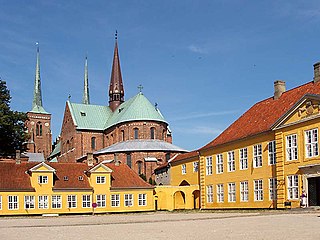
Roskilde is a city 30 km (19 mi) west of Copenhagen on the Danish island of Zealand. With a population of 52,580, the city is a business and educational centre for the region and the 10th largest city in Denmark. It is governed by the administrative council of Roskilde Municipality.

Sweyn Estridsson Ulfsson was King of Denmark from 1047 until his death in 1076. He was the son of Ulf Thorgilsson and Estrid Svendsdatter, and the grandson of Sweyn Forkbeard through his mother's line. He was married three times, and fathered 20 children or more out of wedlock, including the five future kings Harald Hen, Canute the Saint, Oluf Hunger, Eric Evergood, and Niels.
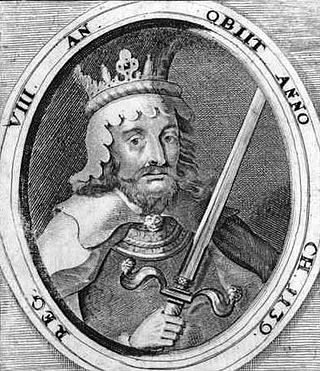
Eric II the Memorable was king of Denmark between 1134 and 1137. Eric was an illegitimate son of Eric I of Denmark, who ruled Denmark from 1095 to 1103. Eric the Memorable rebelled against his uncle Niels of Denmark, and was declared king in 1134. He punished his adversaries severely, and rewarded his supporters handsomely. He was killed by a subject in 1137 and was promptly succeeded by his nephew Eric III of Denmark.
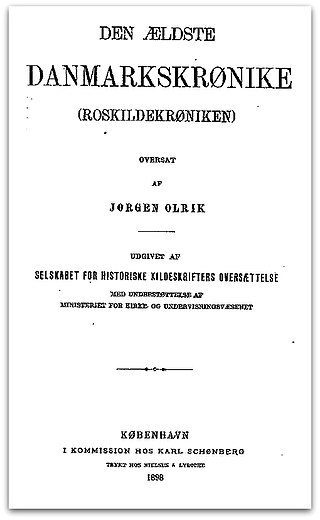
Chronicon Roskildense is a small Danish historical work, written in Latin. It is one of the oldest known attempts to write a coherent account of Danish history by a Danish author, spanning from the introduction of Christianity in Denmark to the author's own time in the middle of the 12th century.
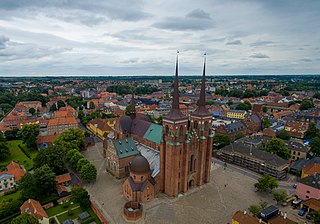
Roskilde Cathedral, in the city of Roskilde on the island of Zealand (Sjælland) in eastern Denmark, is a cathedral of the Lutheran Church of Denmark.

Harald Kesja (1080–1135) was the son of Eric I of Denmark and anti-king of Denmark.
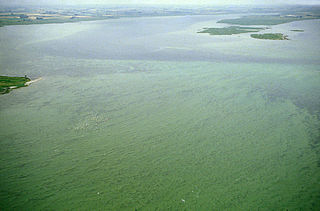
Battle of Fotevik was fought between forces of King Niels of Denmark and his son Magnus Nilsson, against those of Erik Emune on 4 June 1134 at the bay of Fotevik in Skåne.
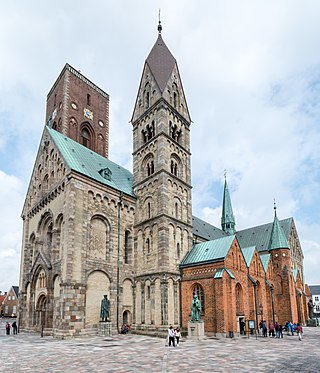
Ribe Cathedral or Our Lady Maria Cathedral is located in the ancient city of Ribe, on the west coast of southern Jutland, Denmark. It was founded in the Viking Era as the first Christian church in Denmark by Ansgar, a missionary monk from Hamburg, under permission of the pagan King Horik I. The cathedral has experienced several damaging events throughout its long history and has been restored, expanded and decorated repeatedly. As it stands today, Ribe Cathedral is the best preserved Romanesque building in Denmark, but reflects a plethora of different architectural styles and artistic traditions. It ranks among the most popular tourist attractions in Denmark and has been awarded two stars in the Michelin guide.
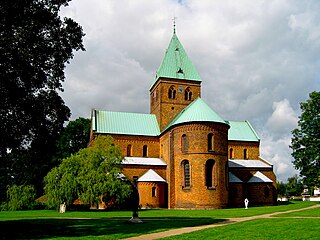
St. Bendt's Church is a church in Ringsted, Denmark, which was originally part of a Benedictine monastery that burnt down in the 18th century. Built in the Romanesque style, it is the oldest brick church in Scandinavia, dating back to about 1170 when it replaced a travertine church from about 1080. It is considered to be one of Denmark's architecturally finest churches. Furthermore, it is of special historical interest as it is the first Royal church in Denmark and it houses the tombs of many of Denmark's earlier monarchs and noblemen.
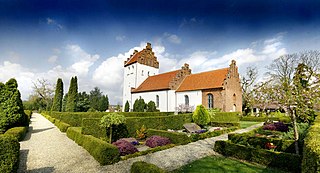
Skjalm Hvide, was the Earl of Zealand in Denmark in the end of the Viking Age (793–1066) and up to his death. Skjalm's father was Toke Trylle, whose father was Slag, based on Absalon, a medieval account scanned, translated and published by Google.

The House of Estridsen was a dynasty that provided the kings of Denmark from 1047 to 1412. The dynasty is named after its ancestor Estrid Svendsdatter. The dynasty is sometimes called the Ulfinger, after Estrid's husband, Ulf Jarl. The dynasty also provided three medieval rulers of Sweden and one of Norway. Their family coat of arms became the coat of arms of Denmark and therefore influenced the coat of arms of Tallinn and the coat of arms of Estonia.
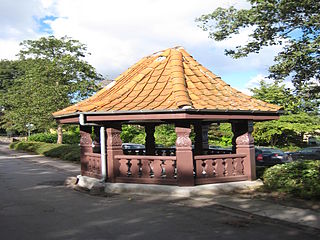
Maglekilde is the most powerful of several natural springs in Roskilde, Denmark. It formerly issued water at a rate of some 90,000 litres per hour but has now dropped to 15,000 litres per hour. A wellhouse was built over the spring in 1927. The building was listed in the Danish registry of protected buildings and places in 1979.

Lyngby Søndre Mølle, literally Lyngby Southern Mill, is a defunct watermill on Mølleåen located at Lyngby Hovedgade, Kongens Lyngby, in the northern suburbs of Copenhagen, Denmark. The current building is from 1902. The name distinguishes it from nearby Lyngby Nordre Mølle.
Winnie Liljeborg is a Danish businesswoman, investor and philanthropist. She was one of the founders of Pandora and is now one of the wealthiest women in Denmark with a net worth of DKK 4.9 billion.
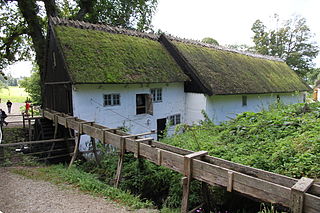
Tadre Watermill is a watermill on Taderød Bæk, a tributary of Elverdams Å, in Lejre Municipality, between Roskilde and Tølløse, some 30 kilometres west of Copenhagen, Denmark. It is now operated as a museum and nature centre under Roskilde Museum. It used to belong to Aastrup Manor.

The Danish Civil Wars were a series of civil wars fought in the Kingdom of Denmark, first from 1131 to 1134 over the murder of Canute Lavard, then from 1139 to 1143, and finally a war of succession fought from 1146 to 1157, after the abdication of Eric III of Denmark, the first monarch in Danish history to have abdicated. The first phase of the war was fought between King Eric II of Denmark and King Niels joined by Magnus the Strong. The second phase of the war was fought between the son of Magnus the Strong, Canute V of Denmark, the son of Eric II of Denmark, Sweyn III of Denmark, and his cousin Valdemar I of Denmark, son of Canute Lavard. The civil wars marked an increase in the influence of the Holy Roman Empire in Denmark, and for a time after, Denmark was a vassal state of Emperor Frederick I. The war ended with the deaths of seven kings. Two of the kings, Olaf Haraldsen and Magnus the Strong, are not amongst the official Danish line of kings. The other kings are Niels I, Eric II, Eric III, Canute V and Sweyn III.
The Battle of Værebro took place in the year 1133 at the Værebro river, on the isle of Zealand.
Events from the 12th century in Denmark.